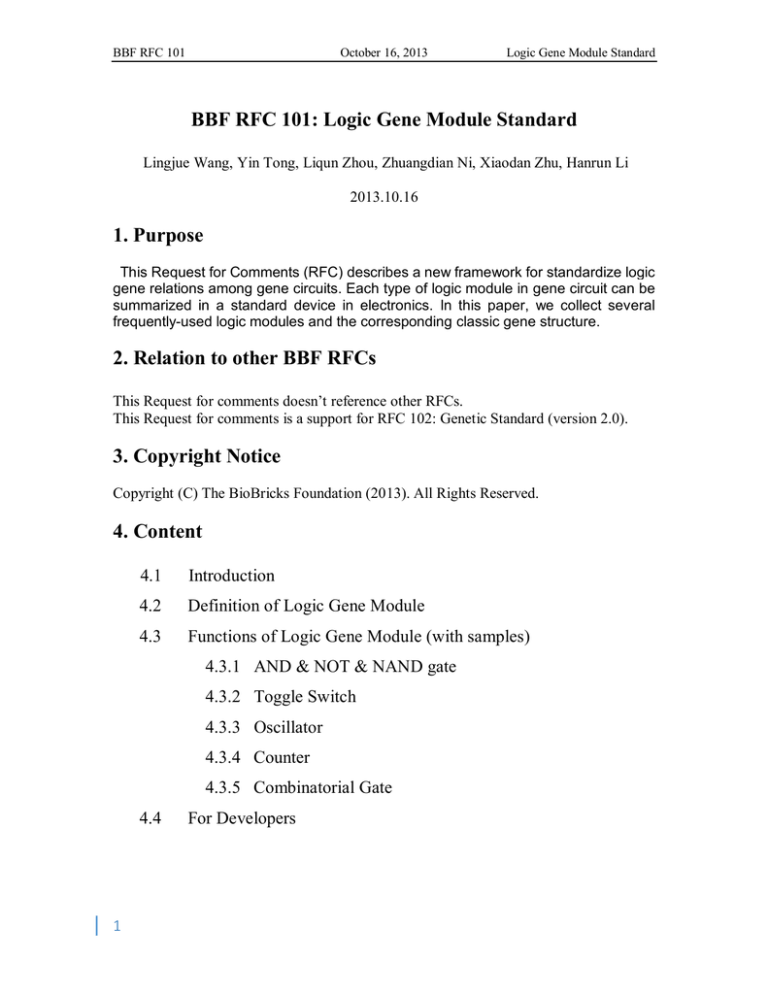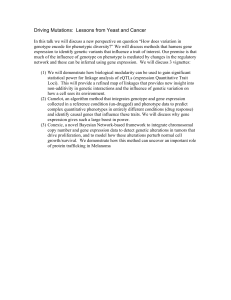
BBF RFC 101
October 16, 2013
Logic Gene Module Standard
BBF RFC 101: Logic Gene Module Standard
Lingjue Wang, Yin Tong, Liqun Zhou, Zhuangdian Ni, Xiaodan Zhu, Hanrun Li
2013.10.16
1. Purpose
This Request for Comments (RFC) describes a new framework for standardize logic
gene relations among gene circuits. Each type of logic module in gene circuit can be
summarized in a standard device in electronics. In this paper, we collect several
frequently-used logic modules and the corresponding classic gene structure.
2. Relation to other BBF RFCs
This Request for comments doesn’t reference other RFCs.
This Request for comments is a support for RFC 102: Genetic Standard (version 2.0).
3. Copyright Notice
Copyright (C) The BioBricks Foundation (2013). All Rights Reserved.
4. Content
4.1
Introduction
4.2
Definition of Logic Gene Module
4.3
Functions of Logic Gene Module (with samples)
4.3.1 AND & NOT & NAND gate
4.3.2 Toggle Switch
4.3.3 Oscillator
4.3.4 Counter
4.3.5 Combinatorial Gate
4.4
1
For Developers
BBF RFC 101
October 16, 2013
Logic Gene Module Standard
4.1 Introduction
So far, there are plenty of genetic circuits executing various functions. Among them,
different types of logic modules are used to regulate the genetic network. In order to
construct a genetic circuit more conveniently and regularly, we establish this standard
to sort out several classic frameworks for the logic gene modules of gene circuits.
Additionally, this standard will be continuously updated since the regulatory modules
can be assembled into more complicated modules.
4.2 Definition of Logic Gene Module
To meet the need of a logic gene circuit, a logic gene module SHOULD
be a specific gene device which SHOULD function like an electron
component which can accept some certain stimulation and emit some
other signals. A logic gene module SHOULD be designed based on a
specific and functional logic component in electronics such as the AND
gate. Furthermore, it MUST be constructed of the standardized
biobricks so that it WILL fully compatible with other parts of the gene
circuit.
4.3 Functions of Logic Gene Module (with samples)
Logic gene module has various functions. It can judge the input conditions and give
a disparate output result. It can either amplify or diminish the input signals. Anyways, a
logic gene module MUST execute a certain function. Here are some classic samples of
logic gene modules:
AND & NOT & NAND gate
AND gate is a basic logic gate that implements logical conjunction. A HIGH output
results only if both the inputs to the AND gate are HIGH. If neither or only one input to
the AND gate is HIGH, a LOW output results. C= A·B.
Standard input and output of Logic AND gate
Input A
Input B
Output C
1
1
1
1
0
0
0
1
0
0
0
0
In the sample, the σ54 hrpL promoter is activated only when both input genes are
expressed under the environment-responsive promoters Plac & PBAD (Figure1.a). And the
result is shown in Figure1.b.
2
BBF RFC 101
October 16, 2013
(a)
Logic Gene Module Standard
(b)
Figure1 (a) A classic sample diagram of AND gate. (b) The result of the sample. Only the Arabinose and IPTG are both existing in a certain
concentration can the PhrpL gene be activated and as a result producing the green fluorescent protein.
The NOT gate (inverter) is a basic logic gate that implements logical negation. A
HIGH output results only if the input to the NOT gate is LOW. If input to the NOT gate
is HIGH, a LOW output results. C=NOT A.
Standard input and output of Logic AND gate:
Input
1
0
A
Output
0
1
Not A
In the sample, under the presence of red light, the kinase activity of Cph8 is inhibited,
precluding the transfer of a phosphoryl group (light green circle) to the response
regulator OmpR (orange dumbbell) and subsequent transcription from the ompC
promoter (PompC). The dark sensor therefore functions as a NOT light transcriptional
logic gate (Figure2.a).
(a)
(b)
Figure2 (a) A classic sample diagram of NOT gate. (b) The result of the sample. When the red light appears, there is a big change of the phosphoryl
group concentration.
The NAND gate is a basic logic gate that implements logical conjunction. A HIGH
output results only if both the inputs to the NAND gate are LOW. If neither or only one
input to the NAND gate is LOW, a HGIH output results. C=NOT (A·B).
3
BBF RFC 101
October 16, 2013
Logic Gene Module Standard
Standard input and output of Logic NAND gate:
Input A
1
1
0
0
Input B
1
0
1
0
Output C
0
0
0
1
In the sample, the GFP protein is not expressed only when both input genes
are expressed under the environment-responsive promoters (Plac and PBAD), and in other
cases the GFP protein is expressed.
(a)
(b)
Figure3 (a) A classic sample diagram of AND gate. (b) The result of the sample. The GFP expressed much more when the Arabinose and IPTG
decrease in a small concentration.
Toggle Switch
A toggle switch is a class of electrical switches that are manually actuated by a
mechanical lever, handle, or rocking mechanism. The word "toggle" is a reference to a
kind of mechanism or joint consisting of two arms, which are almost in line with each
other, connected with an elbow-like pivot. However, the phrase "toggle switch" is
applied to a switch with a short handle and a positive snap-action, whether it actually
contains a toggle mechanism or not. Similarly, a switch where a definitive click is heard,
is called a "positive on-off switch".
Input A
Input B
on ‘A’ off ‘B’
on ‘B’ off ‘A’
In the classic sample, repressor 1 inhibits transcription from Promoter 1 and is
induced by Inducer 1. Repressor 2 inhibits transcription from Promoter 2 and is
induced by Inducer 2.
(a)
Figure4 (a) A standard framework of genetic toggle switch. (b) The mathematical model of the genetic toggle switch.
4
(b)
BBF RFC 101
October 16, 2013
Logic Gene Module Standard
Oscillator
An oscillator is a semiconductor device, consisting of a semiconductor specimen
placed in magnetic field, and a resistor after a power supply. The device produces highfrequency oscillations, which are very close to sinusoidal.
Input
Output
Electronic
DC (Direct Current) (start)
AC (Alternating Current)
Biology
Positive start
Oscillating feedback
In the sample, external stimulus or the circuit itself will firstly start with
expressing the positive feedback protein and enhancing promoter. In the first cycle, two
kinds of proteins increase. When the repressed protein increases to a certain degree, the
promoter will be repressed and as a result, causing a negative feedback. Two proteins
decrease until the negative impact eliminate and the promoter will start to work again.
And the state of the circuit come back to the original state. Following that the oscillator
circuit will enter another cycle.
(a)
(b)
Figure5 (a) A standard framework of genetic oscillator. One promoter with two regulatory proteins (a repressed one and a enhanced one) (b) the
result of a genetic oscillator. The overall concentration of the product is increasing.
5
BBF RFC 101
October 16, 2013
Logic Gene Module Standard
Counter
In digital logic and computing, a counter is a device which stores (and sometimes
displays) the number of times a particular event or process has occurred, often in
relationship to a clock signal.
Input
Output
impulse
number of times
T7 RNAP is the gene at the first node driving transcription of T3 RNAP, which
ultimately drives transcription of GFP. All transcripts are likewise cis-repressed with the
same ribo-regulator sequence. When pulsed with arabinose, this counter should
primarily produce T7 RNAP proteins during the first pulse, T3 RNAP proteins during
the second pulse, and GFP proteins during the third pulse.
(a)
6
(b)
BBF RFC 101
October 16, 2013
Logic Gene Module Standard
(c)
Figure6 (a) A sample of genetic counter (the genetic module). (b) The diagram of the mechanism. (c) The result of the sample.
Combinatorial gate
A combinatorial gate is composed of some logic gates such as the AND, NOT,
NOR, NAND gates, etc. As you design the electric circuits, these logical gene gates can
be connected in parallel or in series or even both. This combination can bring more
complicated and stratified regulatory network.
(a)
(b)
(c)
Figure7 these figures are some kinds of combinatorial gates. (a) The repressilator circuit. (b) Toggle switch. (c) Circuit to decode two incoming
signals.
A sample of combinatorial gate:
(a)
(b)
Figure8 Genetic circuit to measure the device physics of an R3/P3 inverter: digital logic circuit and the genetic regulatory network implementation
(Px: promoters, Rx: repressors, CFP/YFP: reporters).
In the sample, P1 promoter regulates the expression of R2. R2 is expressed
constitutively and the gate’s output is high. R2 is the repressor for promoter P2. P2
regulates R3. If we add an external inducer I2 which can bind R2 and as a result R2 cannot
7
BBF RFC 101
October 16, 2013
Logic Gene Module Standard
bind to the operator site of P2. A reporter CFP is placed downstream of R3 to give a
signal. What’s more, R3 is a repressor of promoter P3. There is another reporter YFP
located in downstream of P3. This circuit can be applied with different
repressor/promoter pairs. ( E.g: P1=λ P ( R-O12 ) , P2=PLtetO-1, P3=p(lac). Inducer I2=
anhydrotetracycline(aTc). R2 =TetR protein and R3=LacI protein).
4.4 For Developers
Based on this standard, we always welcome everyone to add new logic gene
modules like we’ve introduced above. If you have some new ideas about the logic
gene modules you can email any of us (Our email addresses will be listed below).
This standard is established for supporting the genetic circuit standard.
5. Author’s Contact Information
Lingjue Wang:
Yin Tong:
Liqun Zhou:
Hanrun Li:
sustc.mikewong@gmail.com
ty25177@yahoo.com.cn
jimzhou225@gmail.com1
lizhongminde@126.com
Zhuandian Ni: nileenstropy@gmail.com
Xiaodan Zhu: zxdedgar@gmail.com
6. References
Ari E. Friedland,et al (2009) Synthetic Gene Networks That Count. Science 324:1199.
J Hasty, D McMillen, JJ Collins (2002) Engineered gene circuits. Nature 420:224-230.
J Hasty, M Dolnik, V Rottschäfer, JJ Collins. (2002) Synthetic Gene Network for
Entraining and Amplifying Cellular Oscillations. Phys. Rev. Lett. 88, 148101.
RON WEISS∗, SUBHAYU BASU, SARA HOOSHANGI. (2003)Genetic circuit building
blocks for cellular computation, communications, and signal processing. Natural
Computing 2: 47–84
8







